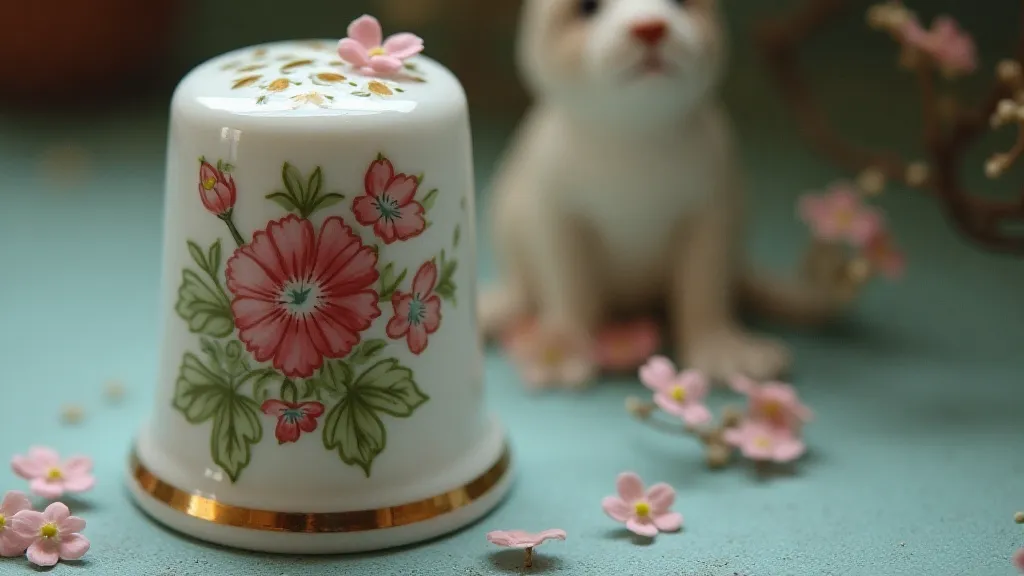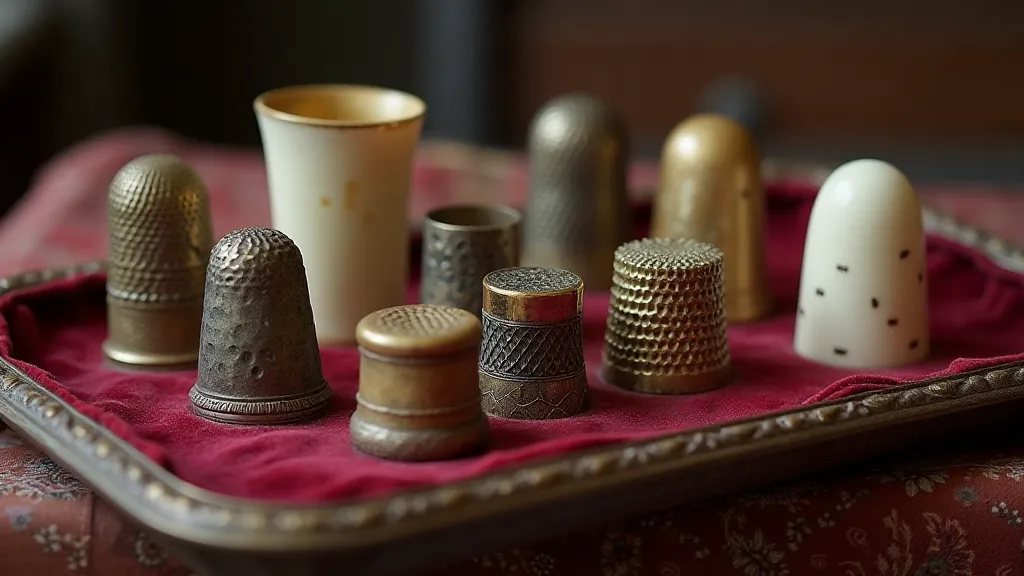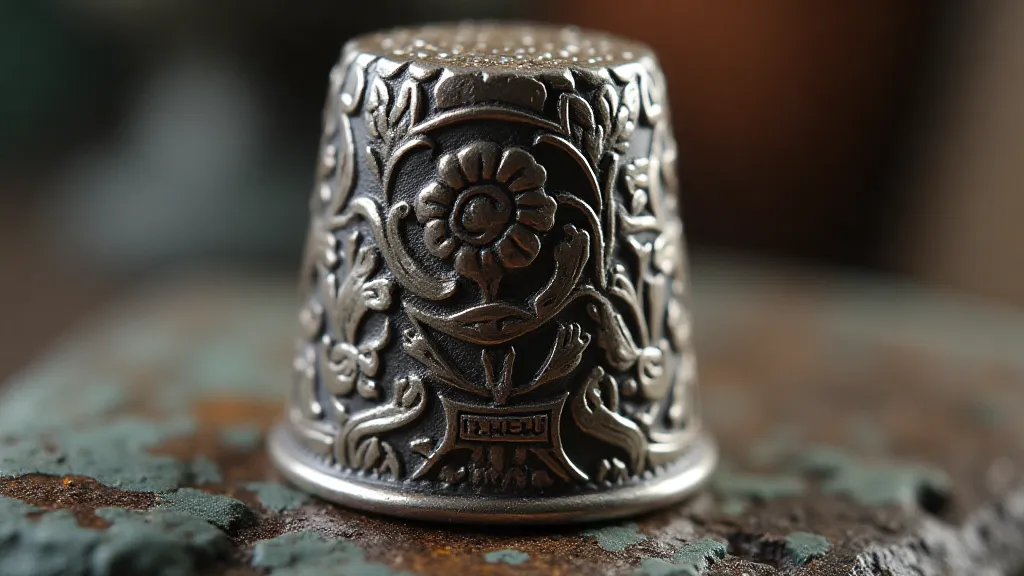The Silent Chorus: Aural Connections Between Sewing and Collecting
There's a quiet music to the world of antique thimbles, a subtle harmony often missed by hurried eyes and ears. It’s not a melody played for concert halls, but a delicate chorus woven from the ghosts of domesticity, the echoes of craftsmanship, and the whisper of generations past. For those who listen closely, the clink of metal against metal, the sigh of worn fabric, the imagined rhythm of a needle’s dance—it’s a symphony of forgotten moments, and it’s intrinsically linked to the joy of collecting these miniature treasures.
My own journey into the world of antique thimbles began not with a passionate desire to *collect*, but with a yearning to connect. My grandmother, Elsie, was a seamstress. Not a professional, but a woman whose hands seemed to instinctively know the language of fabric. Her sewing room, a small, sun-drenched space at the back of her house, was a sanctuary. The hum of her Singer sewing machine, the snip of scissors, and the constant, almost meditative, tap of her thimble against the needle—these were the sounds of my childhood. It wasn't about fashion or style; it was about creating, about nurturing, about the quiet satisfaction of bringing something tangible into the world.
It was after she passed that I began to sift through her belongings. Amongst the spools of thread and carefully folded patterns, I found a small tin box filled with thimbles. Each one was different - some silver, some brass, others made of bone or even intricately painted porcelain. Suddenly, the sounds of her sewing room weren’t just memories; they were vibrations, resonating within those tiny objects. I realized then that these weren't just tools; they were vessels, holding the essence of her skill and her dedication.

The Sounds of Creation: More Than Just a Tool
The purpose of a thimble is simple: to protect the finger while sewing. But for centuries, thimbles evolved beyond mere practicality. Early thimbles, dating back to the Middle Ages, were often made of leather or wood, representing a utilitarian need rather than a desire for adornment. As metalworking skills advanced, so too did the artistry of thimble-making. Silver and brass thimbles became more common, often stamped with intricate designs or personalized with initials. The sound they produced – a sharper, more resonant click – spoke of a higher level of craftsmanship and a growing appreciation for beauty in everyday objects.
Consider the difference between a plain, functional thimble and one meticulously chased with Victorian floral motifs. The former simply protects the finger; the latter tells a story. The sound it makes is different, too - a quieter, more refined chime that hints at the care and attention invested in its creation. It becomes less about the act of sewing and more about the artistry of the maker, a miniature masterpiece held within the hand. The intricate details often found in these decorative thimbles also highlight how they sometimes incorporate precious stones, hinting at the jeweler’s secret to elevating the humble thimble.
Materials and Their Music
The material a thimble is made from profoundly impacts its sound and its perceived value. Silver thimbles, often found in elaborate designs from the Victorian and Edwardian eras, produce a clear, ringing tone. Brass thimbles, more common in earlier periods, have a warmer, slightly muted sound. Bone thimbles, once prevalent due to their availability, emit a soft, almost muffled click. And the rarer pewter or copper thimbles offer unique tonal qualities that are highly sought after by collectors.
Beyond the metallic elements, the age of the thimble also plays a crucial role. Years of use, even gentle use, will subtly alter the metal’s surface, rounding edges and softening the sound. A well-loved, antique silver thimble will often possess a unique resonance, a testament to its history and the hands that guided it. The styles of these thimbles, often reflecting wider trends in textile design, can provide fascinating insights into a pocketful of memories and the evolution of fashion and craft.
Collecting: Preserving the Silent Chorus
Collecting antique thimbles isn’t just about acquiring objects; it's about preserving a legacy. It's about connecting to the women and men who toiled at their sewing machines, creating garments and embellishments that clothed families and adorned homes. Each thimble is a tiny monument to their skill and perseverance.
Restoration is a delicate matter. While cleaning is sometimes necessary to remove layers of grime, overly aggressive methods can strip away the patina—that subtle aging that contributes to a thimble’s character and value. Many collectors prefer to leave the patina untouched, embracing the signs of age as evidence of a thimble’s history. A simple, gentle polishing with a soft cloth is often the best approach.

Beyond the Practical: Symbolic Significance
Throughout history, thimbles have acquired symbolic meaning beyond their function. They’re often associated with thrift, domesticity, and female accomplishment. They've been given as tokens of affection, engraved with sentimental messages, and even incorporated into jewelry. Some cultures view thimbles as lucky charms, believing they protect against misfortune. The precision engineering sometimes seen in older examples, and even those made of simple materials, reveals a clockmaker’s legacy and the skill of those who crafted them.
The popularity of thimble collecting surged in the late 19th and early 20th centuries, particularly in England and America. Thimble societies and clubs sprang up, providing a forum for collectors to share their knowledge and trade specimens. This heightened appreciation led to a flourishing of creativity among thimble makers, resulting in a remarkable diversity of styles and designs. Regional variations in design, particularly, can tell fascinating stories about the craftsmanship and traditions of different communities.

The Art of Regional Styles and Identification
The geographical origin of a thimble often contributes significantly to its value and historical significance. Identifying regional styles is akin to deciphering a coded language, each motif and design element carrying a silent story of its maker and its intended audience. Victorian-era England, for example, developed its own distinctive style, heavily influenced by the Aesthetic movement, featuring intricate floral patterns and often incorporating delicate enameling. American thimbles, particularly those produced in the Northeast, often reflected the practicality and resourcefulness of the frontier era, showcasing simpler designs and frequently utilizing readily available materials like pewter and horn. Understanding the subtle nuances in these regional variations can be a rewarding and challenging pursuit for the dedicated collector.
Beyond the broad strokes of national styles, even smaller regions contributed to unique thimble designs. Certain villages or workshops specialized in specific motifs or techniques, creating highly sought-after pieces amongst collectors. For example, certain areas in Germany were renowned for their elaborate silver chasing techniques, while others excelled in the art of enamel decoration. Unraveling these localized styles requires a keen eye for detail and a deep understanding of the historical context in which they were created. These nuances also demonstrate how the language of embellishment often speaks volumes about a thimble’s origin and the cultural values of its time.
The Resonance Continues
The world of antique thimbles is a microcosm of human history – a testament to our ingenuity, our creativity, and our enduring connection to the past. Listening for the subtle chorus – the faint click of metal, the imagined rhythm of a needle’s dance - invites us to appreciate the artistry and the history embedded within these tiny treasures. It’s a journey that connects us to the generations who came before, and a reminder that even the smallest objects can hold the biggest stories. And perhaps, by preserving these delicate relics, we can keep the silent chorus echoing for generations to come.





